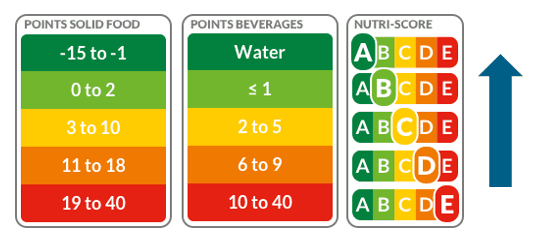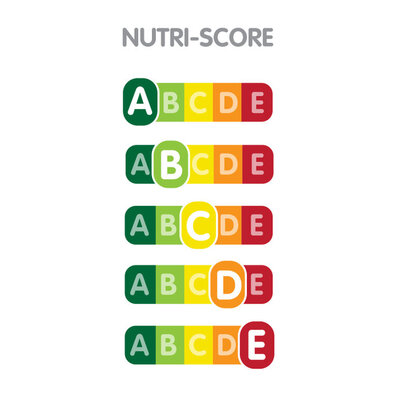Origin
The Nutri-Score was created by Santé Publique France, the French public health agency, based on the work of Professor Serge Hercberg from University of Paris 13 Nord. The front-of-pack logo was developed to facilitate consumers’ understanding of the nutritional information, thus helping them in making informed choices.
How is the Nutri-Score calculated?
The underlying nutritional scoring method was developed by the British Food Standard Agency and is known as the ‘FSA score’. This score, which goes from -15 (best nutritional quality) to 40 (worse nutritional quality), allows consumers to evaluate the overall nutritional quality of food.
Based on 100 grams of solid food product, or 100 mL of liquid food product, the Nutri-Score incorporates unfavorable (negative) and favorable (positive) factors:
Negative factors (0 – 40 points):
- Calories or kilojoules (0 – 10 points)
- Saturated fatty acids (g) (0 – 10 points)
- Simple sugars (g) (0 – 10 points)
- Sodium (mg) (0 – 10 points)
Positive factors (0 – 15 points):
- Protein (g) (0 – 5 points)
- Fiber (g) (0 – 5 points)
- Fruits, vegetables, legumes, nuts, and olive, nut, and colza oils (0 – 5 points)
Results are expressed in a score from -15 (the best) to +40 (the worst) and a class (A-B-C-D-E).
Application
The Nutri-Score allows consumers to:
- Compare the nutritional quality of foods from different categories
- Compare the nutritional quality of foods belonging to the same category (e.g. breakfast cereals, sweet goods, dairy products)
- Compare the nutritional quality of the same food offered by different brands
An example of how Nutri-Score is calculated
The Negative Component of the Nutri-Score corresponds to the sum of the points accumulated (from 0 to 10) based on the food product’s nutritional composition. It can range from 0 to 40 with the lower the score the better the product’s nutritional quality.
| Points | Energy density (KJ / 100 g) | Saturated fats (g / 100 g) | Simple sugars (g / 100 g) | Sodium (mg /100 g) |
|---|---|---|---|---|
| 0 | ≤ 335 | ≤ 1 | ≤ 4.5 | ≤ 90 |
| 1 | > 335 | > 1 | > 4.5 | > 90 |
| 2 | > 670 | > 2 | > 9 | > 180 |
| 3 | > 1,005 | > 3 | > 13.5 | > 270 |
| 4 | > 1,340 | > 4 | > 18 | > 360 |
| 5 | > 1,675 | > 5 | > 22,5 | > 450 |
| 6 | > 2,010 | > 6 | > 27 | > 540 |
| 7 | > 2,345 | > 7 | > 31 | > 630 |
| 8 | > 2,680 | > 8 | > 36 | > 720 |
| 9 | > 3,015 | > 9 | > 40 | > 810 |
| 10 | > 3,350 | > 10 | > 45 | > 900 |
Total N points: N = 1 + 2 + 3 + 8 = 14
The Positive Component of the Nutri-Score corresponds to the sum of the points accumulated (from 0 to 5) based on the amount of fruits, vegetables, pulses, nuts and rapeseed, walnut and olive oils in the food product. It can range from 0 to 15, and the higher the score the better.
| Points | Fruits, vegetables, rapeseed oil, walnut oil and olive oil (%) | Fibers (g / 100 g) | Proteins (g / 100 g) |
|---|---|---|---|
| 0 | ≤ 40 | ≤ 0.9 | ≤ 1.6 |
| 1 | > 40 | > 0.9 | > 1.6 |
| 2 | > 60 | > 1.9 | > 3.2 |
| 3 | – | > 2.8 | > 4.8 |
| 4 | – | > 3.7 | > 6.4 |
| 5 | > 80 | > 4.7 | > 8.0 |
Total P points: N = 0 + 1 + 4 = 5

Healthiness (blue arrow) increases with increased Nutri-Score.
Nutri-Score = Total Negative points – Total Positive points = 14 – 5 = 9 → C
Regulation
The Nutri-Score has been recommended by Belgian, Spanish, German and Dutch authorities, and is welcomed by the World Health Organization. The European Commission (EC) will look into the development of a pan-European mandatory scheme in 2022.
References
- Santé Publique France, Nutri-Score, https://www.santepubliquefrance.fr/en/nutri-score, Accessed 19 July 2021.
- ColRuytGroup, What is the Nutri-Score?, https://nutriscore.colruytgroup.com/colruytgroup/en/about-nutri-score/, Accessed 19 July 2021.

